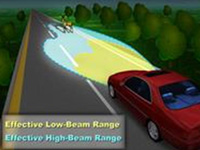
New Headlight Sensors Make Night Driving Safer
It's no secret that driving at night is more dangerous than driving during daylight hours. But just how much more dangerous is nighttime driving?
Recent National Highway Transportation Safety Administration (NHTSA) statistics show that, despite lower traffic volume at night, 42 percent of all crashes and 58 percent of fatal crashes occur after dark. In addition, 67 percent of all pedestrian fatalities occur after dark. So what can drivers do to improve nighttime driving safety?
 |
| Smartbeam Optimizes High Beam Usage |
While alcohol, fatigue and glare can play a role in nighttime accidents, the primary factor is reduced visibility. Drivers are essentially reliant on artificial sources of light to see the road as well as pedestrians, vehicles, animals or other potential hazards.
In addition, most drivers fail to adjust their speed relative to their ability to see the road ahead. In fact, by driving above 45 miles per hour, drivers are at risk of "out driving" the reach of their headlights at the low-beam setting — and seriously compromising their ability to react and stop safely.
One practical safety measure that drivers can take is to maximize the use of their high beams, which can provide an additional 100 feet or more of forward lighting. As easy as it sounds, many drivers are simply not taking advantage of the additional visibility and safety provided by their high beams.
In fact, research by the University of Michigan Transportation Research Institute shows that drivers use their high beams less than 25 percent of the time in which conditions justify their use.
Studies point to several probable reasons why drivers underutilize their high beams. They may be fearful of blinding oncoming drivers, they may become annoyed with the repetitive task of turning them on and off, or they are simply inattentive and forget.
Whatever the reason, the potential safety implications have not gone unnoticed. One Michigan-based company, Gentex, has taken to supplying the worldwide automotive industry with automatic-dimming rearview mirrors and other safety-oriented features.
"Clearly, many drivers are not taking full advantage of the safety benefits associated with using their high beams," said Fred Bauer, Gentex CEO. "Fortunately our high-beam assist technology can improve nighttime driving safety by optimizing high beam usage and taking over the burdensome task of switching between low and high beams."
The innovative product offered by Gentex is called SmartBeam, a high-beam headlamp assist technology that consists of a tiny camera and microprocessor located in an syncd automatic-dimming rearview mirror. The camera responds to light conditions in front of the vehicle and through a complex series of algorithms, automatically turns the high beams "on" and "off" at the appropriate time. The feature is currently available on select North American vehicles.
Designed to increase high-beam usage and eliminate a repetitive task, SmartBeam consumer research shows positive results. In a recent study conducted by The Planning Edge, a Detroit-area research firm, drivers of vehicles equipped with SmartBeam said that they actually used their high beams 50 percent more often than they did prior to having SmartBeam. And nearly 70 percent said they felt safer driving at night with the SmartBeam feature.
(Source: Gentex) |